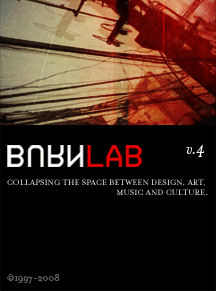Since I'm now officially writing for three different design news sites [the one you're looking at + Core77 and Computerlove], it may take some adjustment to figure out what information to post where. Since Burnlab is home base, you can generally expect longer, more detailed rants here... for better or worse. Anyway, below are some highlights from the Things That Think consortium at the M.I.T. Media Lab earlier this week. Thanks to Jaron Rothkop I got to meet innumerable creative geniuses and got to play with some technology that will literally change the way we live. So where to start?
Perhaps not the most significant to mankind's progress, but very ingenious is the newest version of DJ I-Robot. This machine is basically the opposite of Final Scratch, playing real records on custom built computer controlled turntables. My favorite feature is the ability to program rhythms through scratching with the software interface... like an analog sampler of sorts. With the capability to 'fast forward' at up to 800 RPM, it must destroy records and needles at an impressive rate.
Of great interest to designers is a project by Aesthetics and Computation Group research assistant Simon Greenwold, first debuted about a year ago. Installation allows the user to draw objects in three dimensional space, and then pick up the screen and walk around the object as if it is physically in the room. The implications are staggering. As Simon says [no pun intended], "The fundamental idea is that once a work object is contextualized in space it has shared platform for simultaneous manipulation." Meaning that multiple users can access and manipulate information: be it an architectural design, large system engineering, a product or abstract information.
Speaking of manipulating information in physical space, Hiroshi Ishii's Tangible Media Group is dedicated to exploring language in its purest sense and developing better was to mediate information. Illuminating Clay is an interface that "allows users to explore and analyze free form spatial models. Three-dimensional geometry is captured in real time using a laser scanner. From this information simulations such as shadow casting, land erosion, visibility and travelling time are calculated. Finally, the results are projected back onto the clay model." Astoundingly elegant is the ongoing "Bottles" project. Custom glass bottles of different shape and size give out specific frequencies when uncorked, and can be assigned different types of audible information. This bottles can be assigned anything from musical instruments, to metaphorical information related to data interpreted from a web browser. The bottles can even be assigned voices and carry on a conversation.
Thursday, October 17, 2002
Posted by:
Unknown
at
10/17/2002 08:38:00 PM
![]()
Subscribe to:
Post Comments (Atom)

No comments:
Post a Comment